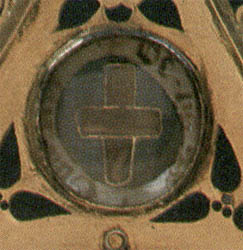Into Year Thirty-Five,
Musings on a Monstrance and a Swamp
Sandy and I celebrated our thirty-fourth anniversary on July 6, 2002, in St. Martinville, the cultural capitol of “Cajun” Louisiana. We spent Friday night at the Castillo Bed and Breakfast, built in the eighteen-thirties along Bayou Teche and next door to the celebrated Evangeline Oak of Longfellow’s poem.
We spent part of Saturday walking around St. Martinville, going in and out of museums and shops and the old St. Martin de Tours Catholic Church. ‘St. Martin is one of the oldest churches in the state, it was established in 1765. The present ediface (sic.), built in 1836, has an 1883 replica of the Grotto of Lourdes. Jean Francois Mouchet’s painting of St. Martin of Tours forms part of the main alter (sic.). Behind the left wing of the church is the grave of Emmeline Labiche, thought to be the heroine of Henry Wadsworth Longfellow’s poem “Evangeline.” A statue of Evangeline stands in the churchyard.’
While walking around in this
beautiful, old church, I noticed that it had more than one monstrance.
One was in a little chapel, and it held the Sacred Host (This is
the consecrated wafer that has ceased to be bread and has now been
transubstantiated into the actual, literal, life-giving substance of
Christ himself, including his body and blood, and, therefore, is just as
much deserving of our reverence and respect as if the Lord himself stood
before us; indeed, according to Tridentine doctrine, it is the Lord
himself.). The other
monstrance was in the main sanctuary, and I could not determine what was
in it. I wondered if it contained a relic from Saint Martin of
Tours, the fourth century bishop so revered by the French — most of his
relics were destroyed by the Huguenots (my French ancestors) in 1562, but
some did remain.
A monstrance is “a vessel designed for the more convenient exhibition of some object of piety. Both the name ostensorium and the kindred word monstrance . . . were so employed as to allow the contents to be readily distinguished, whether the object thus honoured were the Sacred Host itself or only the relic of some saint.”
In Alexandria, one of our hospitals
and a local church are named for Saint Frances Cabrini, the Italian
immigrant and first American citizen to be canonized by Rome.
About a quarter century ago, after having had lunch with the
priest, I went on a tour of St. Frances Cabrini Catholic Church.
My friend pointed out the beautiful reliquary that was in their
main sanctuary. In it was a
relic of Mother Cabrini herself, a small piece of one of her bones that
was the size and appearance of a fingernail clipping.
As I studied the venerable object, I remember thinking, “Wow, as
soon as Miss Frances was declared a saint, somebody dug her up and chopped
her skeleton into tiny pieces.”
‘The teaching of the Catholic Church with regard to the veneration of relics is summed up in a decree of the Council of Trent (Sess. XXV), which enjoins on bishops and other pastors to instruct their flocks that “the holy bodies of holy martyrs and of others now living with Christ — which bodies were the living members of Christ and ‘the temple of the Holy Ghost’ (I Cor., vi, 19) and which are by Him to be raised to eternal life and to be glorified are to be venerated by the faithful, for through these [bodies] many benefits are bestowed by God on men, so that they who affirm that veneration and honour are not due to the relics of the saints, or that these and other sacred monuments are uselessly honoured by the faithful, and that the places dedicated to the memories of the saints are in vain visited with the view of obtaining their aid, are wholly to be condemned, as the Church has already long since condemned, and also now condemns them.”’
In the afternoon, we took a guided
tour of a nearby swamp. It
was something Sandy had always wanted to do, and it proved to be a
wonderful experience. As we
traveled in the small, flat boat through the water thick with plants, I
found this sanctuary, with its alligators and assortment of herons, and
its vaulted ceiling of bald cypress, draped in Spanish moss, much more awe
inspiring than the one that humans had made in 1836.
But, then again, I am more inclined to be moved to worship the
Creator while watching some of the “guests” of the Crocodile
Hunter,
Steve Irwin, than some of those appearing on TBN.




